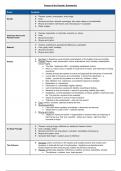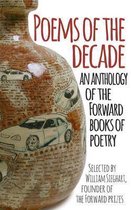Poems of the Decade: Summaries
Poem Analysis
❖ Themes: control, consumption, body image
Eat Me ❖ Tone:
❖ Structure and form: dramatic monologue, free verse makes us uncomfortable
❖ Rhyme and rhythm: half rhymes and 3-line stanzas = incomplete
❖ Water imagery
❖ Themes, masculinity vs. femininity, humanity vs. nature
Chainsaw Versus the ❖ Tone:
Pampas Grass ❖ Structure and form:
❖ Rhyme and rhythm:
❖ Themes: motherhood, generational differences, guilt/regret
Material ❖ Tone: guilty, rueful, nostalgic
❖ Structure and form:
❖ Rhyme and rhythm:
❖ Summary: a disastrous event prompts contemplation on the fragility of life and mortality.
History ❖ Themes: tragedy, hope, preservation, future, ambivalence, time, mortality, existentialism,
human fragility.
➢ The date - September 2001 - immediately established context.
➢ Micro vs. macro: focus on details of ‘local forms of history’ and wider fears of ‘losing
everything’.
➢ Disaster prompts the speaker to notice and appreciate the intricacies of natural life.
➢ Lexical field of innocence and vulnerability: ‘a child’s first nakedness’ / ‘a
toddler…puzzled by the pattern on a shell’ etc. Children = future.
➢ Raw reflection; live, unplanned, unconsidered response to disaster.
➢ Materialism vs. naturalness.
➢ Destruction vs. vulnerability, fragility, delicacy.
➢ Lack of permanence; seeking for stability; everything is fleeting.
➢ Mentions of time and location = search for grounding, stability with reality.
➢ Exploitation, commercialisation and trivialisation of nature: goldfish, ornamental carp
etc. The child as a symbol of the untainted.
➢ Search for answers in a time of mass confusion.
➢ ‘Attentive to the irredeemable’ - what can’t be saved?
❖ Tone: sombre, uncertain; optimistic towards the end.
❖ Structure and form:
➢ Free verse lacks regularity and stability = disconnect and disunity.
➢ Where there is unity in form = collective identity.
❖ Rhyme and rhythm:
➢ Largely no rhyme and rhythm = fragmentations. However there are instances of
half-rhymes (e.g: ‘this’ and ‘razorfish’, ‘states’ and ‘names’, ‘light’ and ‘tide’) =
remnants of hope?
❖ Themes: coming of age, childhood vs. adulthood, freedom, liminal
An Easy Passage ❖ Tone: nostalgic, wistful
❖ Structure and form: one long stanza = transition, inevitability of growing up
❖ Rhyme and rhythm: none
❖ Semantic field of light -> golden years of childhood
❖ Summary: Doshi comments on the injustice and brutality faced by both mothers and
The Deliverer daughters in India with the lack of contraception - daughters are abandoned and
disconnected from their roots because mothers are forced to reproduce.
❖ Themes: gender/class disparity, motherhood, sacrifice, journeys, desirability, outcasts
➢ The deliverer = mothers, nuns, foster parents.
, ➢ Sisters are doing God’s work in a godless world.
➢ Dehumanisation: ‘stuffed in bags’ / ‘feel for penis or no penis, toss the body to the
heap of others’ → as if checking products in a factory.
➢ Americans = saviour complex and oblivious.
➢ Doshi subverts our opinion of the mothers who abandoned these girls.
➢ No named characters = universality to the girl’s experience.
❖ Tone: matter of fact, desensitised, blunt: a disturbing topic doesn’t need dramatisation.
Slightly hopeful in the middle.
❖ Structure and form: tercets convey discordance and inequality; disintegration into couplets
then single lines. Cyclical in terms of hope.
❖ Rhyme and rhythm: none - no unity.
❖ Summary: a farmer’s guilty and unreliable confession of homosexuality and sin.
The Lammas Hireling ❖ Themes: guilt, transgression, homosexuality, the supernatural, memory, religion
➢ ‘Dear late wife’: attempt to extricate himself from guilt of wife’s death? He also
claims he ‘grew fond of company that knew when to shut up’.
➢ Erotic and Gothic imagery of the hireling.
➢ ‘A cow with leather horns’: blends feminine and masculine elements, androgyny,
confuses sexuality, enhances supernatural element. ‘Form’ = feminine body
description.
➢ Connection between wife and hireling.
➢ Lexical field of weight = easing and burdening of guilt and conscience.
➢ Supernatural imagery = metaphor for homosexuality; unconventionality, shame.
➢ ‘It has been an hour since my last confession’: suggests an obsession with religion
as a means of cleansing his guilt, but is still left unsatisfied and unforgiven.
❖ Tone: confessionary. Unreliable narration. Speaker = obsession with money; infatuation with
hireling saving him money.
❖ Structure and form: dramatic monologue, calculated confession to seem believable.
Regulated 6-line stanzas contrast with fluctuations and breakdown of rhyme and rhythm
❖ Rhyme and rhythm: begins with a regular ABCB rhyme, but slowly dissolves into only
occasional rhymes (‘form’ and ‘horns’) and internal rhymes (‘head’ and ‘bread’). The last
stanza lacks rhyme and rhythm altogether, reflecting the loss of self-control.
❖ Themes: childhood, growing up, identity
To My Nine-Year Old Self ❖ Tone: nostalgic
❖ Structure and form:
❖ Themes: appearance vs. reality, sickness, performance, the roles we play in everyday life,
A Minor Role insignificance of daily tasks that contribute to the wider world.
❖ Tone: weaves between inner and outer voice, reassuring
❖ Structure and form: irregular stanzas reflect deteriorating mental state/lack of control, until the
finality of the last line.
❖ Semantic field of politeness. Listing tasks like a shopping list or to-do list.
❖ Summary: A poem that captures and explores shifts in hierarchy and the relationships
The Gun between violence, sex, life and death. Domestic-Gothic.
❖ Themes: violence, gender, power/control, hierarchy, desire
➢ Gun = masculine, male entitlement to space and presence, phallocentric, violence,
power, aphrodisiac, dormant desires.
➢ Violent vs. domestic = masculine vs. feminine = gun vs. ‘green-checked cloth’.
➢ ‘At first’ - ominous, implies further repercussions.
➢ ‘Then a rabbit shot clean through the head’: blunt, abrupt; almost like a shot to the
reader.
➢ At first, then, soon → time; gun exerts dominance.
➢ Describes consequences of using the gun rather than the gun itself.
➢ ‘A gun brings a house alive’: death reminds us of our own mortality.
➢ ‘I join in the cooking’: urge to experience and be included in the masculine world of
action, agency and power. Hierarchy of man over woman → human over animal;





